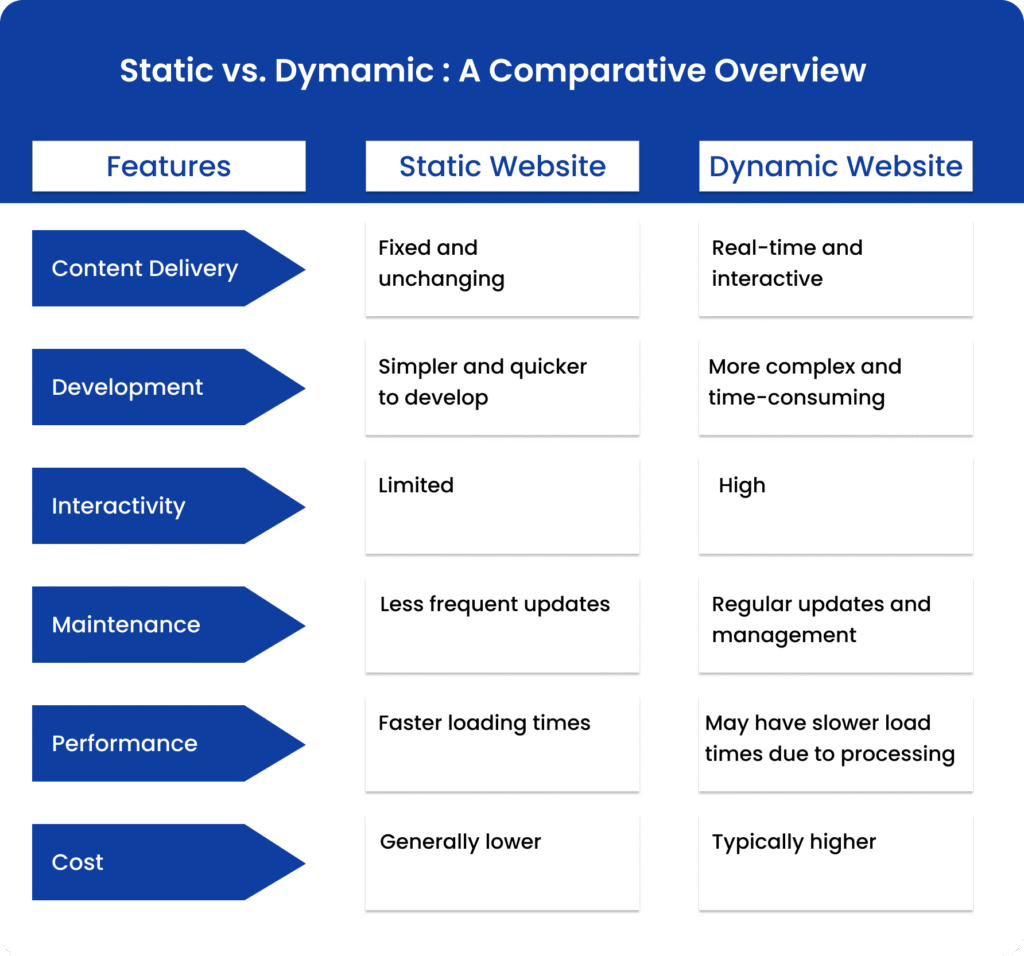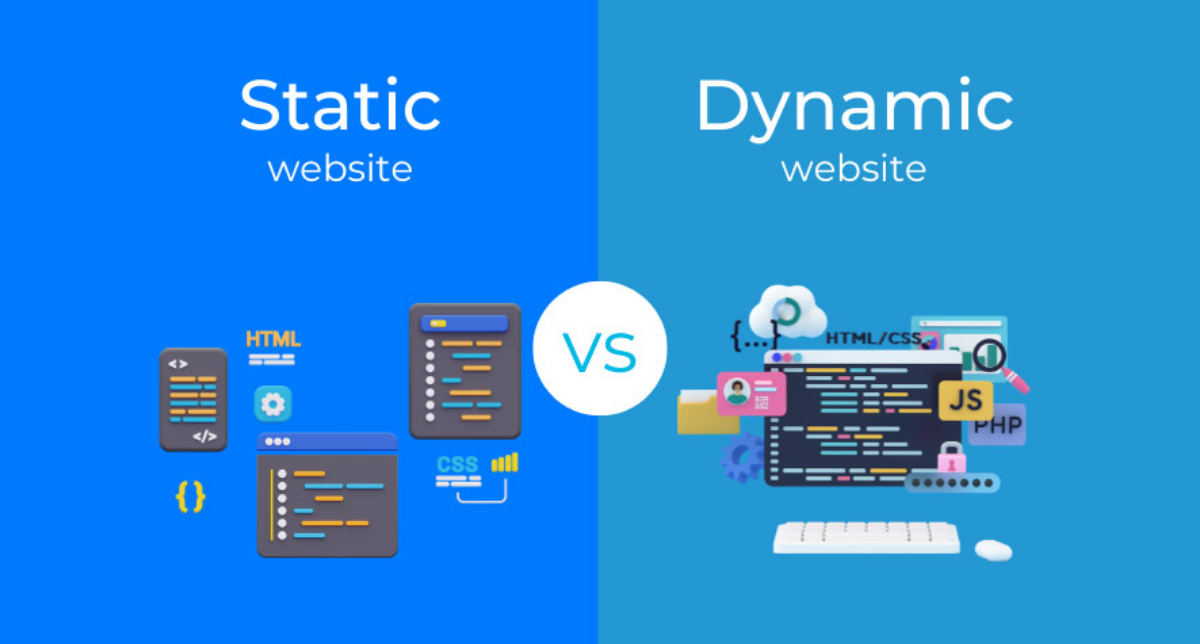In today’s digital world, having a well-designed website is crucial for businesses, brands, and individuals. Whether you’re building a personal blog, an e-commerce platform, or a corporate website, it’s essential to understand the differences between static and dynamic websites. At Technolync, a leading website design company in Texas, we frequently encounter clients unsure about which type of website best fits their needs. In this blog, we’ll explore the differences between static and dynamic websites, their benefits, and why these distinctions matter when making your choice.
What Are Static Websites?
A static website is one where the content stays the same for every visitor. These websites are created using simple HTML, CSS, and occasionally JavaScript. Each page of a static website is a separate file that’s loaded directly from the server to the user’s browser.
Think of a static website as a digital brochure—it offers fixed content that provides a consistent experience for all users. The content remains unchanged unless a developer manually updates the HTML files. Static websites are ideal for scenarios like personal portfolios or small business sites with minimal content updates.
What Are Dynamic Websites?
Dynamic websites, on the other hand, are more interactive and complex. They are built using server-side technologies like PHP, ASP.NET, or JavaScript, often in combination with databases like MySQL. What sets dynamic websites apart is that their content is generated in real-time based on user interactions or external data inputs.
When a user visits a dynamic website, the content displayed is generated dynamically by the server based on specific conditions. For example, an e-commerce site that shows different products based on user preferences or a news website that automatically updates its articles are both dynamic websites.

Key Differences Between Static and Dynamic Websites
Understanding the differences between static and dynamic websites is crucial in determining which is best suited for your business. Let’s break down some key factors:
1. Content Control
- Static Website: Content remains the same for every visitor, and any updates require manual changes to each page’s HTML code. This can be time-consuming, especially for larger sites.
- Dynamic Website: Dynamic websites allow website owners to update content with ease, typically through a Content Management System (CMS) like WordPress, Joomla, or Drupal. These systems allow you to update content without needing extensive coding knowledge. Additionally, dynamic websites support real-time updates based on user interaction.
2. Development Costs
- Static Website: Since static websites are built using simple HTML and CSS, they are more affordable to develop. They don’t require server-side processing, making them an excellent choice for small businesses or individuals with limited budgets.
- Dynamic Website: Dynamic websites are more complex, often involving a backend system and database. This leads to higher development costs, especially if advanced features are required. Dynamic websites tend to be more expensive because they offer greater functionality.
3. Flexibility and Features
- Static Website: Static websites are more limited in terms of features. They deliver the same content to all users and lack interactivity. Adding elements like contact forms or social media integration would require manual coding for each page.
- Dynamic Website: Dynamic websites are highly flexible and feature-rich. They can include interactive features like user registrations, login systems, blogs, e-commerce functionality, and more. They can change content dynamically based on user preferences or behavior, making them ideal for businesses that want to provide a tailored experience to their visitors.
4. SEO (Search Engine Optimization)
- Static Website: While static websites can rank well on search engines, their lack of regular content updates might make it harder to maintain SEO performance over time. Static websites need manual updates to improve SEO, which can be labor-intensive.
- Dynamic Website: Dynamic websites often perform better in terms of SEO. Since they can update content automatically (e.g., adding blog posts or new product pages), they keep the site fresh and improve search engine rankings. Dynamic websites also support advanced SEO features such as custom metadata, A/B testing, and dynamic URL optimization.
5. Website Performance
- Static Website: One of the main benefits of static websites is their fast loading time. Since the content is pre-built and served directly from the server, static websites load quickly, which can significantly enhance user experience and improve conversion rates.
- Dynamic Website: Dynamic websites typically have slower loading times because the content is generated on the fly whenever a user visits a page. This can be especially noticeable if the website relies on a large database or complex server-side processing. However, performance can be optimized through caching and content delivery networks (CDNs).
6. Security
- Static Website: Static websites tend to be more secure than dynamic ones because they don’t rely on databases or server-side scripts. With fewer points of entry, static websites are less vulnerable to attacks, making them a good choice for personal blogs or informational sites that don’t require frequent updates.
- Dynamic Website: Dynamic websites are more susceptible to security issues, especially if they involve complex databases or third-party integrations. Without proper security protocols, dynamic websites can be vulnerable to attacks like SQL injection. It’s important to regularly update software and perform security audits to ensure the safety of a dynamic site.
Which Type of Website is Right for Your Business?
Choosing between a static or dynamic website depends on your business goals and needs:
- Static Website: If you’re looking for a simple, budget-friendly website to display basic information, a static website might be the best option. Static sites work well for portfolios, informational pages, or small businesses that don’t need frequent content changes.
- Dynamic Website: If your business needs a more interactive site with regular content updates, advanced features like e-commerce or user login systems, or personalized experiences for users, a dynamic website is the way to go. Dynamic websites are perfect for businesses that are focused on growth and need flexible, scalable websites.
Final Thoughts
Both static and dynamic websites come with their unique advantages. Static websites are simple, cost-effective, and fast, making them perfect for smaller projects. Dynamic websites, on the other hand, offer greater flexibility, interactivity, and functionality, making them ideal for larger, more complex websites.
At Technolync, we understand the importance of selecting the right website for your business. Whether you’re interested in a static website to establish a basic online presence or a dynamic website to fuel growth, our team is here to help you bring your digital vision to life. Contact us today to discuss your project and let us guide you in choosing the right website for your online presence.

